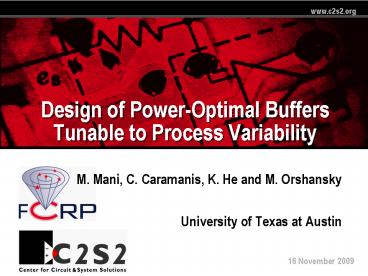Design of PowerOptimal Buffers Tunable to Process Variability - PowerPoint PPT Presentation
1 / 13
Title:
Design of PowerOptimal Buffers Tunable to Process Variability
Description:
Design-Time and Post-Silicon Tuning Based on Affine Policies ... Policies limited to affine functions of the uncertain variables (Leff and Vth) ... – PowerPoint PPT presentation
Number of Views:48
Avg rating:3.0/5.0
Title: Design of PowerOptimal Buffers Tunable to Process Variability
1
Design of Power-Optimal Buffers Tunable to
Process Variability
- M. Mani, C. Caramanis, K. He and M. Orshansky
- University of Texas at Austin
2
Design-Time and Post-Silicon Tuning Based on
Affine Policies
- Developed co-optimization strategy for
design-time and post-silicon yield improvement - Design-time gate sizing
- Post-silicon tuning uses adaptive body biasing
(ABB) - Output of adjustable optimization is a set of
first-stage decisions and a policy - Policies limited to affine functions of the
uncertain variables (Leff and Vth)
3
Adjustable Power-Efficient Buffers on
Timing-Critical Paths
- Multiple target applications for tapered buffers
- Embedded SRAM Both timing paths and power are
dominated by buffer chains driving large wordline
capacitances - I/O circuits Drive large off-chip capacitances
- Clock trees Ensure that skew constraints are
satisfied - Global interconnect Exacerbating wire delays
imply more buffers per unit length - Growth of variability and leakage espouse
low-power adaptive buffer design techniques - Design-time techniques lack ability to react to
actual conditions on chip and impose fixed
overhead - Use an adaptive strategy to reduce average total
energy consumption in large buffers - Pre-design redundant implementations and select
after manufacture depending on uncertainty
4
Expanding Flexibility of Tuning Finite
Adjustable Optimization
- In general, optimization with recourse under
uncertainty follows - General adjustable problems with arbitrary
dependence of variables on uncertain parameters
are NP-hard - For affine functions of the uncertain variables,
we use fast interior point methods - Problem affine formulations assume continuous
adaptability - Often only a small finite number of alternatives
available - Only 2 or 3 threshold voltages, a small number of
cell drive strengths - Second stage decisions are discrete, and chosen
from a finite set of pre-determined contingency
plans - Choice depends on the realization of the
uncertainty - Earlier developed affine methods are not suitable
- Will solve the problem as a finite adaptable
optimization problem under uncertainty
First stage decisions ? Observation of uncertain
variables ? Tune decision variables
5
Buffer Design and Characterization
- Design tuning based on buffer stages with
different drive strengths - Implemented using a tri-state like buffer
configuration - Both branches enabled for high-speed, extra
branch turned off for low-power operation - Delay of buffer modeled as a posynomial function
of transistor widths - Leakage and dynamic power have linear dependence
6
Finite Adaptable Buffer Design Strategy
- A two-stage problem under uncertainty but with
finite adaptability - First stage size buffers
- Second stage determine policy for turning on
branch - Minimize average power with satisfactory
timing-yield - Strategy solving above is equivalent to finding
a partition of uncertainty set - - partitions of uncertainty set, - first
stage decision, - second stage decisions - A second-stage decision corresponds to a
partition
7
Formulating the Delay Constraints
- Consider variability in channel length
- Two possible partitions with as the truncation
point - Two different buffer configurations
- Select branch 1 with probability a1 branch 1 2
with probability a2 - denotes the delay through the buffer
configuration - Delay is monotonic in the process parameters
8
Formulating the Objective Function
- The objective function is the total power of the
configuration - Dynamic power of a buffer computed as the sum of
the dynamic powers of the individual components - Adopt exponential model for leakage power
- Expected value of leakage power of buffer
configuration - where is the cdf of and
is the cdf of
9
Adaptable Buffer Design Problem Solution
- Can re-write the problem as
- where , and are cdf of variables
- For each truncation point, we solve a geometric
program - Find optimal truncation point by a linear sweep
- This describes the optimal policy
- Similar strategy for handling variability in both
L andVth - Seeks partitioning of 2-D uncertainty set
- Use body bias as additional tuning variable to
control area overhead
10
Partitioning Strategy Matters
- There exists an optimal partition for which the
power is minimized - Depends on the yield constraint
- Adaptive scheme produces a savings of 18 in
total power
11
Buffer Design Example
- Designed buffer using optimization flow to obtain
sizes and optimal partition - SPICE simulation performed using 65nm technology
- Optimal Partition - Proportion of low-power
buffer use is 0.78 and high-speed buffer use is
0.22 - Total power savings compared to basic
non-adaptable buffer 18.5 - Area overhead due to control transistors 14.6
12
Monte Carlo Simulation Results
- Significant spread in power and delay
- High-speed buffer used when low-power buffer does
not meet timing
13
Conclusions
- A design strategy for finite adaptability is
being developed - Expands application domain compared to affine
policies - Discrete second stage adaptability potentially
reduces implementation cost - Partition of uncertainty set that dictates buffer
switching policy is crucial to enabling power
savings in adaptive setting - Experiments indicate that up to 18 savings in
total power and 17 savings in leakage are
possible at acceptable area overhead - Multiple target applications where adaptive
buffer design can make a significant impact































